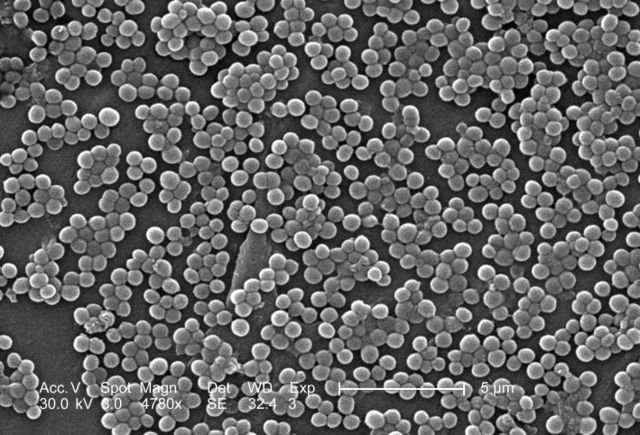From Wikipedia, the free encyclopedia
 Size of this preview: 640 × 435 pixels
Size of this preview: 640 × 435 pixels Full resolution (2,835 × 1,927 pixels, file size: 406 KB, MIME type: image/jpeg)
 |
This is a file from the Wikimedia Commons. The description on its description page there is shown below.Commons is a freely licensed media file repository. You can help.
|
Summary
| Description |
English: This 2005 colorized scanning electron micrograph (SEM) depicted numerous clumps of methicillin-resistant Staphylococcus aureus bacteria, commonly referred to by the acronym, MRSA; Magnified 4780. Recently recognized outbreaks, or clusters of MRSA in community settings have been associated with strains that have some unique microbiologic and genetic properties, compared with the traditional hospital-based MRSA strains, which suggests some biologic properties, e.g., virulence factors like toxins, may allow the community strains to spread more easily, or cause more skin disease. A common strain named USA300-0114 has caused many such of outbreaks in the United States. See PHIL 10045 for a colorized version of this image.
- Methicillin-resistant Staphylococcus aureus infections, e.g., bloodstream, pneumonia, bone infections, occur most frequently among persons in hospitals and healthcare facilities, including nursing homes, and dialysis centers. Those who acquire a MRSA infection usually have a weakened immune system, however, the manifestation of MRSA infections that are acquired by otherwise healthy individuals, who have not been recently hospitalized, or had a medical procedure such as dialysis, or surgery, first began to emerged in the mid- to late-1990's. These infections in the community are usually manifested as minor skin infections such as pimples and boils. Transmission of MRSA has been reported most frequently in certain populations, e.g., children, sports participants, or jail inmates.
|
| Source |
 |
This media comes from the Centers for Disease Control and Prevention's Public Health Image Library (PHIL), with identification number #7820. Note: PHIL pages cannot be bookmarked; instead enter 7820 into the ID search page. Not all PHIL images are public domain; be sure to check copyright status and credit authors and content providers. |
|
| Date |
2005 |
| Author |
- Content Providers: CDC/ Janice Carr/ Jeff Hageman, M.H.S.
|
Permission
( Reusing this image) |
PD-USGov-HHS-CDC English: None - This image is in the public domain and thus free of any copyright restrictions. As a matter of courtesy we request that the content provider be credited and notified in any public or private usage of this image.
|
Licensing
 |
This image is a work of the Centers for Disease Control and Prevention, part of the United States Department of Health and Human Services, taken or made during the course of an employee's official duties. As a work of the U.S. federal government, the image is in the public domain. |
|
File history
Click on a date/time to view the file as it appeared at that time.
|
|
Date/Time |
Dimensions |
User |
Comment |
| current |
14:20, 5 October 2005 |
2,835×1,927 (406 KB) |
MattKingston |
|
File links
The following pages on Schools Wikipedia link to this image (list may be incomplete):


